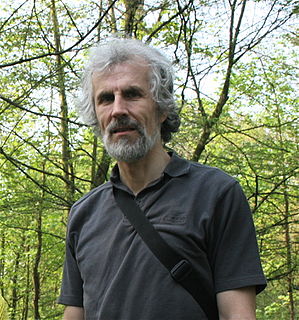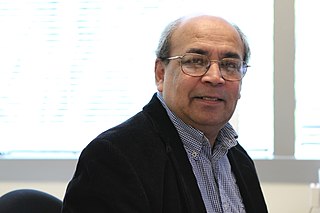Related Research Articles

Evolutionary linguistics or Darwinian linguistics is a sociobiological approach to the study of language. Evolutionary linguists consider linguistics as a subfield of sociobiology and evolutionary psychology. The approach is also closely linked with evolutionary anthropology, cognitive linguistics and biolinguistics. Studying languages as the products of nature, it is interested in the biological origin and development of language. Evolutionary linguistics is contrasted with humanistic approaches, especially structural linguistics.
Bio-inspired computing, short for biologically inspired computing, is a field of study which seeks to solve computer science problems using models of biology. It relates to connectionism, social behavior, and emergence. Within computer science, bio-inspired computing relates to artificial intelligence and machine learning. Bio-inspired computing is a major subset of natural computation.

Luc Steels is a Belgian scientist and artist. Steels is considered a pioneer of Artificial Intelligence in Europe who has made contributions to expert systems, behavior-based robotics, artificial life and evolutionary computational linguistics. He was a fellow of the Catalan Institution for Research and Advanced Studies ICREA associated as a research professor with the Institute for Evolutionary Biology (UPF/CSIC) in Barcelona. He was formerly founding Director of the Artificial Intelligence Laboratory of the Vrije Universiteit Brussel and founding director of the Sony Computer Science Laboratory in Paris. Steels has also been active in the arts collaborating with visual artists and theater makers and composing music for opera.

Rodney Allen Brooks is an Australian roboticist, Fellow of the Australian Academy of Science, author, and robotics entrepreneur, most known for popularizing the actionist approach to robotics. He was a Panasonic Professor of Robotics at the Massachusetts Institute of Technology and former director of the MIT Computer Science and Artificial Intelligence Laboratory. He is a founder and former Chief Technical Officer of iRobot and co-Founder, Chairman and Chief Technical Officer of Rethink Robotics and currently is the co-founder and Chief Technical Officer of Robust.AI.

A multi-agent system is a computerized system composed of multiple interacting intelligent agents. Multi-agent systems can solve problems that are difficult or impossible for an individual agent or a monolithic system to solve. Intelligence may include methodic, functional, procedural approaches, algorithmic search or reinforcement learning.

Dario Floreano is a Swiss-Italian roboticist and engineer. He is director of the Laboratory of Intelligent System (LIS) at the École Polytechnique Fédérale de Lausanne in Switzerland as well as the Swiss National Centre of Competence in Research (NCCR) Robotics.
Evolutionary robotics is an embodied approach to Artificial Intelligence (AI) in which robots are automatically designed using Darwinian principles of natural selection. The design of a robot, or a subsystem of a robot such as a neural controller, is optimized against a behavioral goal. Usually, designs are evaluated in simulations as fabricating thousands or millions of designs and testing them in the real world is prohibitively expensive in terms of time, money, and safety.
An artificial brain is software and hardware with cognitive abilities similar to those of the animal or human brain.

Francis Paul Heylighen is a Belgian cyberneticist investigating the emergence and evolution of intelligent organization. He presently works as a research professor at the Vrije Universiteit Brussel, where he directs the transdisciplinary research group on "Evolution, Complexity and Cognition" and the Global Brain Institute. He is best known for his work on the Principia Cybernetica Project, his model of the Internet as a global brain, and his contributions to the theories of memetics and self-organization. He is also known, albeit to a lesser extent, for his work on gifted people and their problems.
Cognitive Robotics or Cognitive Technology is a subfield of robotics concerned with endowing a robot with intelligent behavior by providing it with a processing architecture that will allow it to learn and reason about how to behave in response to complex goals in a complex world. Cognitive robotics may be considered the engineering branch of embodied cognitive science and embodied embedded cognition, consisting of Robotic Process Automation, Artificial Intelligence, Machine Learning, Deep Learning, Optical Character Recognition, Image Processing, Software Development and System Integration.
Simon M. Kirby is a British cognitive scientist, currently holding the Chair of Language Evolution at the University of Edinburgh, where he is Director of the Graduate School, and Programme Director for the MSc in the Evolution of Language and Cognition. He specializes in evolutionary computational models of human language and its development.

Ronald Craig Arkin is an American roboticist and roboethicist, and a Regents' Professor in the School of Interactive Computing, College of Computing at the Georgia Institute of Technology. He is known for the motor schema technique in robot navigation and for his book Behavior-Based Robotics.
Artificial languages are languages of a typically very limited size which emerge either in computer simulations between artificial agents, robot interactions or controlled psychological experiments with humans. They are different from both constructed languages and formal languages in that they have not been consciously devised by an individual or group but are the result of (distributed) conventionalisation processes, much like natural languages. Opposed to the idea of a central designer, the field of artificial language evolution in which artificial languages are studied can be regarded as a sub-part of the more general cultural evolution studies.
Morphogenetic robotics generally refers to the methodologies that address challenges in robotics inspired by biological morphogenesis.
The LIDA cognitive architecture is an integrated artificial cognitive system that attempts to model a broad spectrum of cognition in biological systems, from low-level perception/action to high-level reasoning. Developed primarily by Stan Franklin and colleagues at the University of Memphis, the LIDA architecture is empirically grounded in cognitive science and cognitive neuroscience. In addition to providing hypotheses to guide further research, the architecture can support control structures for software agents and robots. Providing plausible explanations for many cognitive processes, the LIDA conceptual model is also intended as a tool with which to think about how minds work.
In artificial intelligence research, the situated approach builds agents that are designed to behave effectively successfully in their environment. This requires designing AI "from the bottom-up" by focussing on the basic perceptual and motor skills required to survive. The situated approach gives a much lower priority to abstract reasoning or problem-solving skills.

Artificial life is a field of study wherein researchers examine systems related to natural life, its processes, and its evolution, through the use of simulations with computer models, robotics, and biochemistry. The discipline was named by Christopher Langton, an American theoretical biologist, in 1986. In 1987 Langton organized the first conference on the field, in Los Alamos, New Mexico. There are three main kinds of alife, named for their approaches: soft, from software; hard, from hardware; and wet, from biochemistry. Artificial life researchers study traditional biology by trying to recreate aspects of biological phenomena.
Cognitive biology is an emerging science that regards natural cognition as a biological function. It is based on the theoretical assumption that every organism—whether a single cell or multicellular—is continually engaged in systematic acts of cognition coupled with intentional behaviors, i.e., a sensory-motor coupling. That is to say, if an organism can sense stimuli in its environment and respond accordingly, it is cognitive. Any explanation of how natural cognition may manifest in an organism is constrained by the biological conditions in which its genes survive from one generation to the next. And since by Darwinian theory the species of every organism is evolving from a common root, three further elements of cognitive biology are required: (i) the study of cognition in one species of organism is useful, through contrast and comparison, to the study of another species’ cognitive abilities; (ii) it is useful to proceed from organisms with simpler to those with more complex cognitive systems, and (iii) the greater the number and variety of species studied in this regard, the more we understand the nature of cognition.

Ashok K. Goel is a professor of computer science and human-centered computing in the School of Interactive Computing at Georgia Institute of Technology, and the chief scientist with Georgia Tech's Center for 21st Century Universities. He conducts research into cognitive systems at the intersection of artificial intelligence and cognitive science with a focus on computational design and creativity. Goel is also the executive director of National Science Foundation's AI Institute for Adult Learning and Online Education and an editor emeritus of AAAI's AI Magazine.
Kerstin Dautenhahn is a German computer scientist specializing in social robotics and human–robot interaction. She is a professor of electrical and computer engineering at the University of Waterloo, where she holds the Canada 150 Research Chair in Intelligent Robotics and directs the Social and Intelligent Robotics Research Laboratory.
References
- ↑ Nolfi, Stefano; Floreano, Dario (2000). Evolutionary Robotics: The Biology, Intelligence, and Technology of Self-Organizing Machines. MIT Press.
- ↑ Nolfi, Stefano; Mirolli, Marco (2010). Evolution of Communication and Language in Embodied Agents. Springer Verlag. ISBN 9783642012495 . Retrieved 2008-02-20.
- ↑ Nolfi, Stefano; Marocco, Davide (2007). "Communication in Natural and Artificial Organisms Experiments in Evolutionary Robotics". In Lyon, C.; Nehaniv, C.; Cangelosi, A. (eds.). Emergence of Communication and Language (PDF). Vol. 11. Berlin: Springer Verlag. pp. 189–206. Bibcode:2007ecl..book.....L.
- ↑ Nolfi, Stefano (2021). Behavioral and Cognitive Robotics: An Adaptive Perspective. CNR-ISTC.